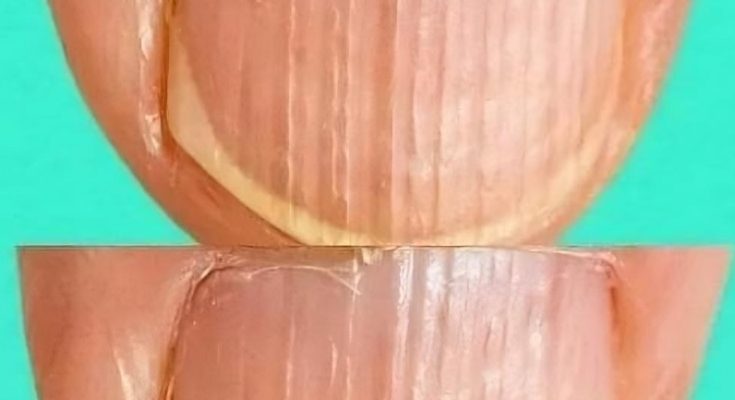Our nails are more than just canvases for polish—they can be a window into our overall health. From texture to color, nails can reveal subtle signs of underlying health issues, alerting us to conditions that may need medical attention. While some changes are harmless and part of aging, others could signal nutritional deficiencies, organ problems, or even systemic illnesses. Let’s dive into the surprising ways your nails reflect your health and what different nail changes might mean.

Vertical Stripes: Natural Aging or Nutritional Deficiencies?
Vertical stripes, or ridges, that run from the cuticle to the tip of the nail are one of the most common nail changes people experience. These longitudinal ridges are typically benign and often become more visible as we age. However, in some cases, pronounced vertical stripes may point to a deficiency in essential vitamins and minerals, such as iron, magnesium, or vitamin B12.
If you notice an increase in vertical ridges that seems abrupt, it might be worth checking for conditions like anemia or thyroid issues, as these deficiencies can sometimes cause such changes in nail texture. So, while vertical stripes can be a normal part of aging, a sudden change could signal a need to review your nutrient intake.
Horizontal Stripes (Beau’s Lines): Signs of Illness or Trauma
Horizontal stripes or indentations, known as Beau’s lines, can indicate more serious health concerns. These grooves are often caused by physical trauma to the nail, but when they appear across multiple nails, they can point to health problems that disrupt normal nail growth. Beau’s lines are sometimes associated with severe illnesses, such as respiratory infections, diabetes, malnutrition, or even heart disease.
The appearance of these lines may coincide with periods of high stress or illness when the body diverts resources away from nail growth. The National Center for Biotechnology Information (NCBI) notes that these lines are often caused by systemic diseases like mumps, pneumonia, and Kawasaki disease. If Beau’s lines appear on all nails, it’s worth seeing a healthcare provider to investigate potential underlying conditions.
White Stripes (Muehrcke’s Lines): Potential Liver or Kidney Concerns
White horizontal stripes that run parallel across the nail, known as Muehrcke’s lines, are another indicator worth noting. Unlike Beau’s lines, Muehrcke’s lines do not indent the nail surface. These lines may appear due to protein deficiencies or imbalances, often related to kidney or liver issues. If you notice these lines on several nails, it’s a good idea to seek medical advice, as they can sometimes be linked to chronic liver disease or malnutrition.
Muehrcke’s lines are more common in individuals with decreased blood protein levels, particularly albumin. Since these lines often disappear when the nail is pressed, it’s a distinctive sign that your body may be signaling the need for further health evaluation.
Brittle Nails: Often a Result of Poor Diet and Nutrition
Brittle, weak, or peeling nails are common complaints and can frequently be attributed to a poor diet rather than a systemic disease. Nails are composed of keratin, a protein that relies on proper nutrition for strength and resilience. A diet lacking in key nutrients like protein, biotin, iron, and zinc can lead to nails that easily break or peel.
Dr. Sara Norris, a naturopathic doctor, notes that brittle nails often reflect poor nutritional intake or digestion. A diet rich in lean proteins, leafy greens, and foods high in vitamins E and B-complex can improve nail health over time. Simple dietary changes may result in stronger, healthier nails and are usually the first approach to tackling brittle nail concerns.

Rippling or Pitted Nails: Possible Autoimmune Issues
When nails develop pits or a rippled surface, it’s more than a cosmetic concern—it could be an indicator of autoimmune diseases such as psoriasis or eczema. People with psoriasis, in particular, often experience pitting in their nails, where small depressions or divots appear on the surface.
Rippling may also be linked to inflammatory arthritis. If you notice these textural changes accompanied by joint pain or skin rashes, it could be worthwhile to speak with a healthcare provider. While nail changes alone may not confirm a diagnosis, they can provide helpful clues for early detection of autoimmune disorders.
Yellowing Nails: Fungal Infections or Respiratory Issues
Yellow nails are a common sign of fungal infections, particularly in toenails where fungi thrive in moist environments. However, yellow nails can also occur in response to respiratory conditions, such as chronic bronchitis, or from excessive use of nail polish without breaks.
When yellowing is due to a fungal infection, you might notice the nail thickening and becoming more brittle over time. Topical antifungal treatments are often effective for mild infections, but if the problem persists, consult a healthcare provider. If you experience yellow nails without any other symptoms, try taking a break from polish and letting your nails breathe to see if the discoloration fades.

Clubbing of Nails: A Sign of Cardiopulmonary Conditions
Nail clubbing, where the nails curve downward and the tips of the fingers swell, is often associated with lung and heart diseases. This change occurs gradually, and people with chronic lung conditions, such as cystic fibrosis or chronic obstructive pulmonary disease (COPD), are at greater risk.
Clubbing can also be related to low oxygen levels in the blood, commonly seen in those with heart disease. If you notice a gradual thickening or rounding of your nails, especially if you experience breathing issues, it’s a good idea to consult a healthcare provider to rule out potential underlying issues.
Dark Stripes: Potential Sign of Melanoma
Dark vertical stripes on the nails, known as melanonychia, can sometimes be harmless, especially in individuals with darker skin tones. However, in rare cases, dark stripes could be a warning sign of melanoma, a serious type of skin cancer. If you see a dark stripe that seems to widen, or if it appears on only one nail, it’s essential to have it checked by a dermatologist.
While most dark streaks are benign, it’s best to err on the side of caution and get professional guidance. Early detection is key with melanoma, and recognizing changes in your nails could lead to timely treatment.
A Well-Balanced Diet for Healthier Nails
Improving nail health often starts with a balanced diet. Protein, vitamins, and minerals are essential for strong, healthy nails, and incorporating nutrient-rich foods can make a difference. Biotin, zinc, vitamin E, and omega-3 fatty acids are especially beneficial for promoting nail growth and strength.
In addition to eating well, staying hydrated helps prevent dry, brittle nails. Consider adding supplements if you struggle to get these nutrients from food, but remember to consult a healthcare professional before starting any new regimen.
Conclusion: Listening to the Story Your Nails Tell
Your nails are not just an aesthetic feature; they’re a valuable source of insight into your overall health. From vertical ridges to yellowing or clubbing, each change can tell a story about what’s happening inside your body. While some nail changes are natural with age, others may indicate nutrient deficiencies or even serious health conditions.
Taking note of these signs and consulting a healthcare provider when necessary can help you address underlying issues early on. So, the next time you glance at your nails, remember—they might be offering you a glimpse into your body’s health status. Pay attention to what they’re saying; it could be more important than you think.



